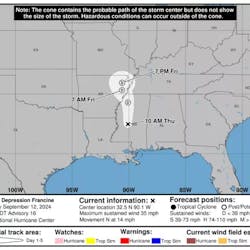BSEE: Nearly 42% of GoM oil production shut-in as Francine moves inland
The US Bureau of Safety and Environmental Enforcement (BSEE) continued to monitor offshore oil and gas operations in the US Gulf of Mexico as Hurricane Francine made landfall as a Category 2 hurricane in Terrebonne Parish, La., late Sept. 11.
As of 10:00 am CDT, now Tropical Depression Francine was moving over central Mississippi with heavy rainfall spreading across portions of Mississippi, Alabama, and the Florida panhandle.
Based on data from offshore operator reports submitted as of 11:30 a.m. CDT Sept. 12, personnel have been evacuated from a total of 169 production platforms, 45.55% of the 371 manned platforms in the Gulf of Mexico, according to the US Bureau of Safety and Environmental Enforcement (BSEE).
Personnel have been evacuated from 3 non-dynamically positioned (DP) rigs, equivalent to 60% of the 5 rigs of this type currently operating in the Gulf.
A total of 2 DP rigs have moved off location out of the storm’s path as a precaution. This number represents 10% of the 20 DP rigs currently operating in the Gulf.
From operator reports, BSEE estimates that about 41.74% (730,472 b/d) of the current oil production and 53.32% (991.68 MMcfd) of the current natural gas production in the Gulf of Mexico has been shut-in.
Production, refining, LNG infrastructure
There are new details from operators about preparations made for oil and gas infrastructure in the hurricane's path.
According to a late Sept. 11 report from S&P Global Commodity Insights, Hurricane Francine threatened about 2 million b/d of refinery capacity.
On Sept. 9, Calcasieu Refining shut its 135,500 b/d plant in Lake Charles, La., S&P Global said, citing a company spokesperson. The move reduced the parish’s operating refinery capacity to 719,000 b/d, S&P Global continued.
In addition to work to secure platforms in the Gulf of Mexico ahead of the storm, ExxonMobil made preparations at its 522,500 b/d Baton Rouge refinery, where the company told S&P Global in an email that operations were continuing as of Sept. 11 as the company continued to monitor and prepare (OGJ Online, Sept. 10, 2024).
In a late morning update Sept. 12, Shell said downstream issues forced the company to curtail production at Appomattox, Mars, Vito, Ursa, and Olympus.
Elsewhere, the operator has begun redeploying personnel at Perdido, while production there and at its Auger and Enchilada/Salsa assets remains shut in. Drilling remains paused at Whale, where operations are expected to begin later this year.
The company said an update on its onshore assets in Louisiana will be provided later today.
Also in the storm’s path were US LNG export plants.
Cheniere's Sabine Pass LNG, Sempra-led Cameron LNG, and Venture Global’s Calcasieu Pass LNG told S&P Global that they were monitoring the storm. Venture Global told S&P Global that it was securing the Plaquemines LNG project and that “small deliveries of natural gas for commissioning activities halted on Sept. 10.” The project is nearing startup.
On Sept. 11, total feedgas demand for the three LNG export plants was about 6.8 bcfd, S&P Global said, compared with an average of about 8.1 bcfd in month’s previous days.

Mikaila Adams | Managing Editor - News
Mikaila Adams has 20 years of experience as an editor, most of which has been centered on the oil and gas industry. She enjoyed 12 years focused on the business/finance side of the industry as an editor for Oil & Gas Journal's sister publication, Oil & Gas Financial Journal (OGFJ). After OGFJ ceased publication in 2017, she joined Oil & Gas Journal and was named Managing Editor - News in 2019. She holds a degree from Texas Tech University.


